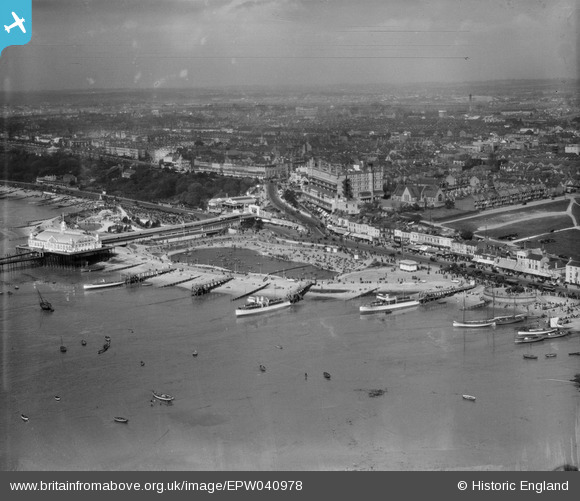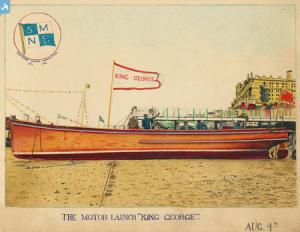 This varnished open excursion launch is the ML King George V of the Southend Motor Navigation Co. Ltd, owned by Albert Brand and W.H. "Bill" Wilson. |

bargee1937 |
Sunday 19th of April 2015 12:02:28 AM |
 This is the 75ft TSMV "Julia Freke", renamed New prince Of Wales I" after WW2. She was built for the Southend motor navigation Co.Ltd., as the first-launched of a pair of 75ft passenger-carrying hulls laid down by Hayward's Boatyard [the other hull was bought by the Myall Family and became the "Britannia I"], which Boatyard was on ground later taken by the Kursaal and the n. end of Burdett Road, and launched by crane from the Corporation Loading jetty, in 1921, I think.
The "Julia Freke" was named after the daughter of the SMNCo's first Chairman of the Board, which was composed of a number of Southend's small-business owners. The "Julia Freke" was also fitted with a handed pair of Parsons' 75hp petrol/paraffin engines, and attained 14 knots "light" on her Sea Trials, making her the fastest pleasure boat on the foreshore, until the arrival of the speedboats in the 1930's, which latter ran from the King George V extension at the Pier Head. Speed was important - the faster you could run when loaded, the more trips could you manage in a tide, and the higher the "Take". For better pictures of all three of the pleasure boats, see the < www.simplonpc.co.uk > website. |

bargee1937 |
Sunday 23rd of November 2014 05:36:04 PM |
 The Myall Family's "big "Britannia", built 1924 by John Thorneycroft & Co, I.o.W., as a near-copy of the already-very-successful "New Prince of Wales". The Myall's didn't volunteer their two vessels for Operation Dynamo until May 27th, - and they were allowed to crew their own vessels. I suspect that, as a result of having their own crews, - and being very lucky as well, - both the 'big' Britannia, and the smaller Britannia I not only survived Dunkirk, but - commandeered afterwards into Naval Coastal Patrol service, they also survived WW2, and returned to civilian passenger service for the 1946 Season. See the simplon pc website for better pictures of all three of these TSMV excursion vessels. |

bargee1937 |
Sunday 23rd of November 2014 05:25:16 PM |
Hi Do you have any more details on the Britannia 1's war Service
Cheers Ian (Skipper Forth Princess formerly Britannia 1) |

ian Hynd |
Wednesday 1st of July 2020 05:32:11 PM |
 This is the Southend Motor Navigation Co's 137ton TSMV New Prince Of Wales [NPoW],built at Mariners Yard, Bosham in W. Sussex in 1922, first Season on the Southend foreshore in 1923, and the largest "twin-internal-combustion-engined, shallow-draught beach excursion vessel" of her time in the UK, - fitted with twin, handed, Parsons 'L'-Series 75hp petrol/paraffin engines [these start using petrol and you switch to paraffin one they warm-up] running Brunton's propellers in tunnels under a slipper stern, to make for good shallow-water handling. . The Board of Trade awarded her a "Steam 6 Passenger Carrying Certificate", the first such awarded to a Southend pleasure boat; and one of only 2 such - the 2nd being to the Myall Family's "big Britannia", shown lying at the next jetty westwards. The NPoW was also the first Southend "pleasure boat" to have a Public Address System, and broadcast music. All SMNCo. employees were preferred to be ex-RN, as this gave a commonality of training and experience. The NPoW was sunk at Dunkirk to enemy shellfire in shallow water, going inwards to the beach off La Panne to rescue soldiers. The NPoW only drew 3ft6ins. of water when when fully-loaded with her usual 400 passengers, so was ideal for this beach rescue operation. But she was also unlucky in that although the Company Owners volunteered to crew all their pleasure boats across the Channel for Operation Dynamo with their own ex-Royal navy staff,- they unfortunately offered their boats to the SNO at Sheerness while the Admiralty was still operating the "no civilians in a combat zone" policy on May 25th/26th. the Policy was changed on may 27th to allow civilian crews to take their own vessels to Dunkirk, - but that was too late for all seven of the SMNCo. motor boats, which had already been commandeered at gunpoint the previous day! We know these details from copies of Adm. RN after-action reports in our family archive show that a very junior Sub.Lieut Peter Bennett was assigned to take command of the NPoW, and a 2nd yr. junior artificer trainee from HMS Sultan [the RN's Artificer School at Sheerness Dockyard] - with no experience of petrol/parafin engines was assigned to run her engines. the RN crew were so inexperienced that they thought she had diesel-engines, and allowed her fuel tanks to be topped-off with diesel fuel, resulting in frequent engine stoppages from fuel contamination all the way to the beaches off La Panne. A number of commandeered small-craft given raw Navy crews, who had little or no small-craft experience, were lost en route from similar causes. All of this information came out at the end of WW2 during the Court Cases against the Admiralty and the Ministry of War Transport to settle the "War Loss Replacement Claims" of civilian owners of commandeered vessels who lost their boats to enemy action - during Operation Dynamo or during the rest of the War. |

bargee1937 |
Sunday 23rd of November 2014 05:18:20 PM |







![[EPW040978] The Boating Pool, the Southend Pier Pavilion and the Palace Hotel, Southend-on-Sea, from the south-east, 1933](http://britainfromabove.org.uk/sites/all/libraries/aerofilms-images/public/100x100/EPW/040/EPW040978.jpg)
![[EPW040975] The Boating Pool, Southend Pier Pavilion and The Shrubbery, Southend-on-Sea, from the east, 1933](http://britainfromabove.org.uk/sites/all/libraries/aerofilms-images/public/100x100/EPW/040/EPW040975.jpg)
![[EPW037024] The Boating Pool, Seaway and environs, Southend-on-Sea, from the south-east, 1931](http://britainfromabove.org.uk/sites/all/libraries/aerofilms-images/public/100x100/EPW/037/EPW037024.jpg)
![[EPW037007] Seaway and environs, Southend-on Sea, from the south, 1931](http://britainfromabove.org.uk/sites/all/libraries/aerofilms-images/public/100x100/EPW/037/EPW037007.jpg)
![[EAW002204] The Pier Pavilion and the town, Southend-on-Sea, from the south-east, 1946](http://britainfromabove.org.uk/sites/all/libraries/aerofilms-images/public/100x100/EAW/002/EAW002204.jpg)
![[EPW036705] The Southend-on-Sea Pier Pavilion, Marine Parade and the town, Southend-on-Sea, from the south, 1931](http://britainfromabove.org.uk/sites/all/libraries/aerofilms-images/public/100x100/EPW/036/EPW036705.jpg)
![[EPW036723] The seafront, Marine Parade and the town, Southend-on-Sea, 1931. This image has been affected by flare.](http://britainfromabove.org.uk/sites/all/libraries/aerofilms-images/public/100x100/EPW/036/EPW036723.jpg)
![[EAW002205] The Pier Pavilion, The Cliffs and the town, Southend-on-Sea, from the south-east, 1946](http://britainfromabove.org.uk/sites/all/libraries/aerofilms-images/public/100x100/EAW/002/EAW002205.jpg)
![[EAW002206] The Pier Pavilion and sea front, Southend-on-Sea, from the east, 1946](http://britainfromabove.org.uk/sites/all/libraries/aerofilms-images/public/100x100/EAW/002/EAW002206.jpg)
![[EPW062741] The Southend Pier Pavilion, Marine Gardens and the Boating Pool, Southend-on-Sea, 1939](http://britainfromabove.org.uk/sites/all/libraries/aerofilms-images/public/100x100/EPW/062/EPW062741.jpg)
![[EPW000553] Southend-on-Sea, from the south-east, 1920](http://britainfromabove.org.uk/sites/all/libraries/aerofilms-images/public/100x100/EPW/000/EPW000553.jpg)
![[EAW002218] The Boating Pool and sea front, Southend-on-Sea, 1946](http://britainfromabove.org.uk/sites/all/libraries/aerofilms-images/public/100x100/EAW/002/EAW002218.jpg)
![[EPW016549] Marine Parade and environs, Southend-on-Sea, 1926](http://britainfromabove.org.uk/sites/all/libraries/aerofilms-images/public/100x100/EPW/016/EPW016549.jpg)
![[EAW053074] Marine Parade and Seaway, Southend-on-Sea, 1954](http://britainfromabove.org.uk/sites/all/libraries/aerofilms-images/public/100x100/EAW/053/EAW053074.jpg)
![[EPW000550] Southend-on-Sea, from the south-east, 1920](http://britainfromabove.org.uk/sites/all/libraries/aerofilms-images/public/100x100/EPW/000/EPW000550.jpg)
![[EAW026899] The Pier Pavilion and Marine Gardens, Southend-on-Sea, from the south-east, 1949. This image was marked by Aerofilms Ltd for photo editing.](http://britainfromabove.org.uk/sites/all/libraries/aerofilms-images/public/100x100/EAW/026/EAW026899.jpg)
![[EAW024662] Marine Gardens, Royal Hill and the town, Southend-on-Sea, from the south-east, 1949](http://britainfromabove.org.uk/sites/all/libraries/aerofilms-images/public/100x100/EAW/024/EAW024662.jpg)
![[EPW000549] Southend-on-Sea, from the south-east, 1920](http://britainfromabove.org.uk/sites/all/libraries/aerofilms-images/public/100x100/EPW/000/EPW000549.jpg)
![[EPW054671] Marine Parade, Southend-on-Sea, 1937](http://britainfromabove.org.uk/sites/all/libraries/aerofilms-images/public/100x100/EPW/054/EPW054671.jpg)
![[EPW000552] Marine Parade, Western Esplanade and the seafront, Southend-on-Sea, from the east, 1920. This image has been produced from a damaged print.](http://britainfromabove.org.uk/sites/all/libraries/aerofilms-images/public/100x100/EPW/000/EPW000552.jpg)
![[EPW054672] Marine Parade and the Boating Pool, Southend-on-Sea, 1937](http://britainfromabove.org.uk/sites/all/libraries/aerofilms-images/public/100x100/EPW/054/EPW054672.jpg)
![[EAW002217] The Boating Pool, Southend-on-Sea, 1946](http://britainfromabove.org.uk/sites/all/libraries/aerofilms-images/public/100x100/EAW/002/EAW002217.jpg)
![[EPW062742] The Southend Pier Pavilion, Marine Gardens and the Boating Pool, Southend-on-Sea, 1939](http://britainfromabove.org.uk/sites/all/libraries/aerofilms-images/public/100x100/EPW/062/EPW062742.jpg)
![[EAW026906] Southend Pier, Southend-on-Sea, from the north, 1949. This image has been produced from a print.](http://britainfromabove.org.uk/sites/all/libraries/aerofilms-images/public/100x100/EAW/026/EAW026906.jpg)
![[EPW058500] Marine Parade, Southend-on-Sea, 1938](http://britainfromabove.org.uk/sites/all/libraries/aerofilms-images/public/100x100/EPW/058/EPW058500.jpg)
![[EPW037015] The Pier Pavilion, Boating Pool, Palace Hotel and environs, Southend-on-Sea, from the south-east, 1931](http://britainfromabove.org.uk/sites/all/libraries/aerofilms-images/public/100x100/EPW/037/EPW037015.jpg)
![[EAW002201] The Boating Pool, Pier Pavilion and environs, Southend-on-Sea, 1946](http://britainfromabove.org.uk/sites/all/libraries/aerofilms-images/public/100x100/EAW/002/EAW002201.jpg)
![[EPW062738] The Southend Pier Pavilion, Marine Gardens and the Boating Pool, Southend-on-Sea, 1939](http://britainfromabove.org.uk/sites/all/libraries/aerofilms-images/public/100x100/EPW/062/EPW062738.jpg)
![[EPW037016] Marine Parade and environs, Southend-on-Sea, from the south-west, 1931](http://britainfromabove.org.uk/sites/all/libraries/aerofilms-images/public/100x100/EPW/037/EPW037016.jpg)
![[EPW062740] The Southend Pier Pavilion, Marine Gardens and the Boating Pool, Southend-on-Sea, 1939](http://britainfromabove.org.uk/sites/all/libraries/aerofilms-images/public/100x100/EPW/062/EPW062740.jpg)
![[EPW039868] Marine Gardens, the Pier Pavilion and Marine Parade, Southend-on-Sea, 1932](http://britainfromabove.org.uk/sites/all/libraries/aerofilms-images/public/100x100/EPW/039/EPW039868.jpg)
![[EPW000551] Southend-on-Sea, from the south, 1920](http://britainfromabove.org.uk/sites/all/libraries/aerofilms-images/public/100x100/EPW/000/EPW000551.jpg)
![[EPW036725] The Southend-on-Sea Pier Pavilion, the Marine Parade Boating Pool and St John the Baptist's Church, Southend-on-Sea, 1931](http://britainfromabove.org.uk/sites/all/libraries/aerofilms-images/public/100x100/EPW/036/EPW036725.jpg)
![[EAW053089] The Pier Pavilion and Boating Pool, Southend-on-Sea, 1954](http://britainfromabove.org.uk/sites/all/libraries/aerofilms-images/public/100x100/EAW/053/EAW053089.jpg)
![[EPW062739] The Southend Pier Pavilion, Marine Gardens and the Boating Pool, Southend-on-Sea, 1939](http://britainfromabove.org.uk/sites/all/libraries/aerofilms-images/public/100x100/EPW/062/EPW062739.jpg)
![[EAW002199] Marine Gardens, Boating Pool, the Pier Pavilion and Marine Parade, Southend-on-Sea, 1946](http://britainfromabove.org.uk/sites/all/libraries/aerofilms-images/public/100x100/EAW/002/EAW002199.jpg)
![[EAW002202] The Pier Pavilion, Royal Hill and the town, Southend-on-Sea, 1946](http://britainfromabove.org.uk/sites/all/libraries/aerofilms-images/public/100x100/EAW/002/EAW002202.jpg)
![[EAW002200] Marine Gardens, Boating Pool and the Pier Pavilion, Southend-on-Sea, 1946](http://britainfromabove.org.uk/sites/all/libraries/aerofilms-images/public/100x100/EAW/002/EAW002200.jpg)
![[EAW043703] The Marine Gardens and Pier Pavilion, Southend-on-Sea, 1952](http://britainfromabove.org.uk/sites/all/libraries/aerofilms-images/public/100x100/EAW/043/EAW043703.jpg)
![[EAW002198] Marine Gardens, Boating Pool and the Pier Pavilion, Southend-on-Sea, 1946](http://britainfromabove.org.uk/sites/all/libraries/aerofilms-images/public/100x100/EAW/002/EAW002198.jpg)





